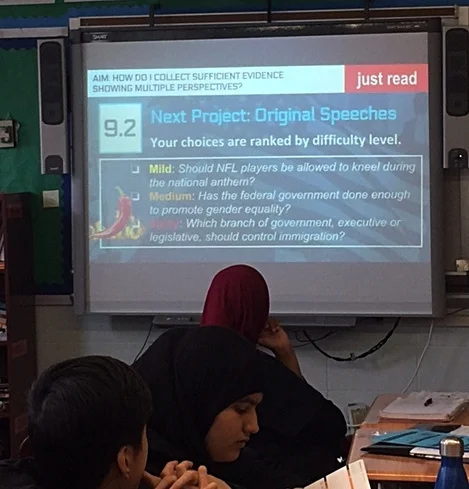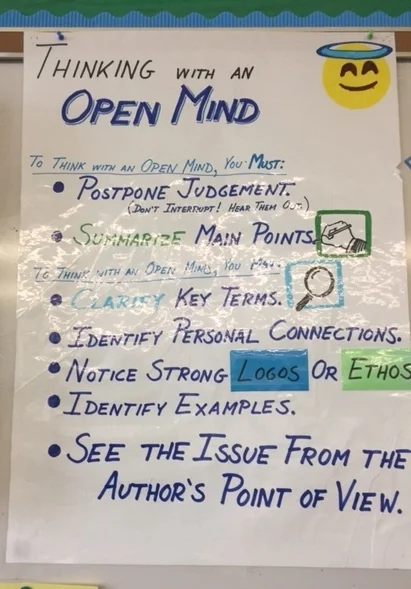By Meg Stentz
Sometimes the “ah-ha” moment comes from finally understanding the why of competency shifts, and sometimes they happen from seeing the how in action. Today we share some of the how’s we saw in action at MC Active Member Origins High School in Brooklyn.
Creating a supportive environment
Clarifying strategies allow students to access text and work even when they have questions.
“We know kids space out. We want them to be able to space out. They are allowed to space out; we just need them to come back.” —Dan, 9th grade ELA teacher
Simple ways kids are supported in refocusing:
In every 9th grade classroom, lessons all share certain identical visual components. On every slide in the lesson slide deck, the learning aim is in the top left corner, the task is in the top right, and there’s a timer in the bottom corner. Instructions or context are in the center.
If the students are working with a certain resource, there’s a photo of the resource on the slide. So, even if you miss the teacher’s framing of an activity, you can glance up and easily identify all the materials you need.
By November, students are comfortable with the cognitive routines to use when they encounter something they don’t understand. (See picture: “Clarifying Strategies”)
Guiding students in building metacognition
At the end of the year, students participate in round table discussions about their learning journey for specific outcomes. The whole year supports students in gathering information that could support them in their roundtable experience.
Students track their own mastery across time. (See below.)
Rubrics at Origins are often used across disciplines to give students more perspective about how to apply a given skill—and teachers spend significant time working with student to unpack rubrics criteria. Students understand that “more of a 3 is not a 4,” but that instead, they’re being asked to engage in deeper thinking. When students receive feedback, they immediately set a goal and action plan with next steps to improve their mastery.
Before independent work time, students record on a google form what outcome they’ll spend their time working on. At the end of that work time, they’ll complete a google form exit ticket about how their work time went. When it comes time for roundtables, they’ll have a print-out that tracks how they spent their time.
Engaging students with relevance & rigor
At Origins, these buzz words come alive as students engage in work that is related to their lives, tied to current events, and interesting to them.
Cross-curricular learning asks students to use background knowledge from History to demonstrate a skill they’re developing in ELA.
Classrooms where the learning matters to students stand apart. At Origins, 9th grade history students are practicing research and writing with textual evidence by analyzing and reflecting on sources around race, gender, and immigration issues.
Cross-curricular outcomes allow students to hone their skills. In 9th grade ELA, Origins students are leveraging the same research outcomes as well as their understanding of pathos and logos to write speeches. Students self-select into topic groups based on how much background knowledge they have to tackle first amendment issues through the NFL’s stance on allowing players to kneel, the role of government in promoting gender equity, or checks and balances through the lens of immigration..
The Origins rubric asks students to synthesize multiple arguments. To support students in this complex task, students are asked write with “an open mind” and “a skeptical mind.” This explicit instruction supports students in working towards the highest level of mastery. (See below.)
Big thanks to Mohamad Awad and Dan Farrell, Social Studies and ELA teachers at Origins, for this enlightening glimpse into their classrooms!






